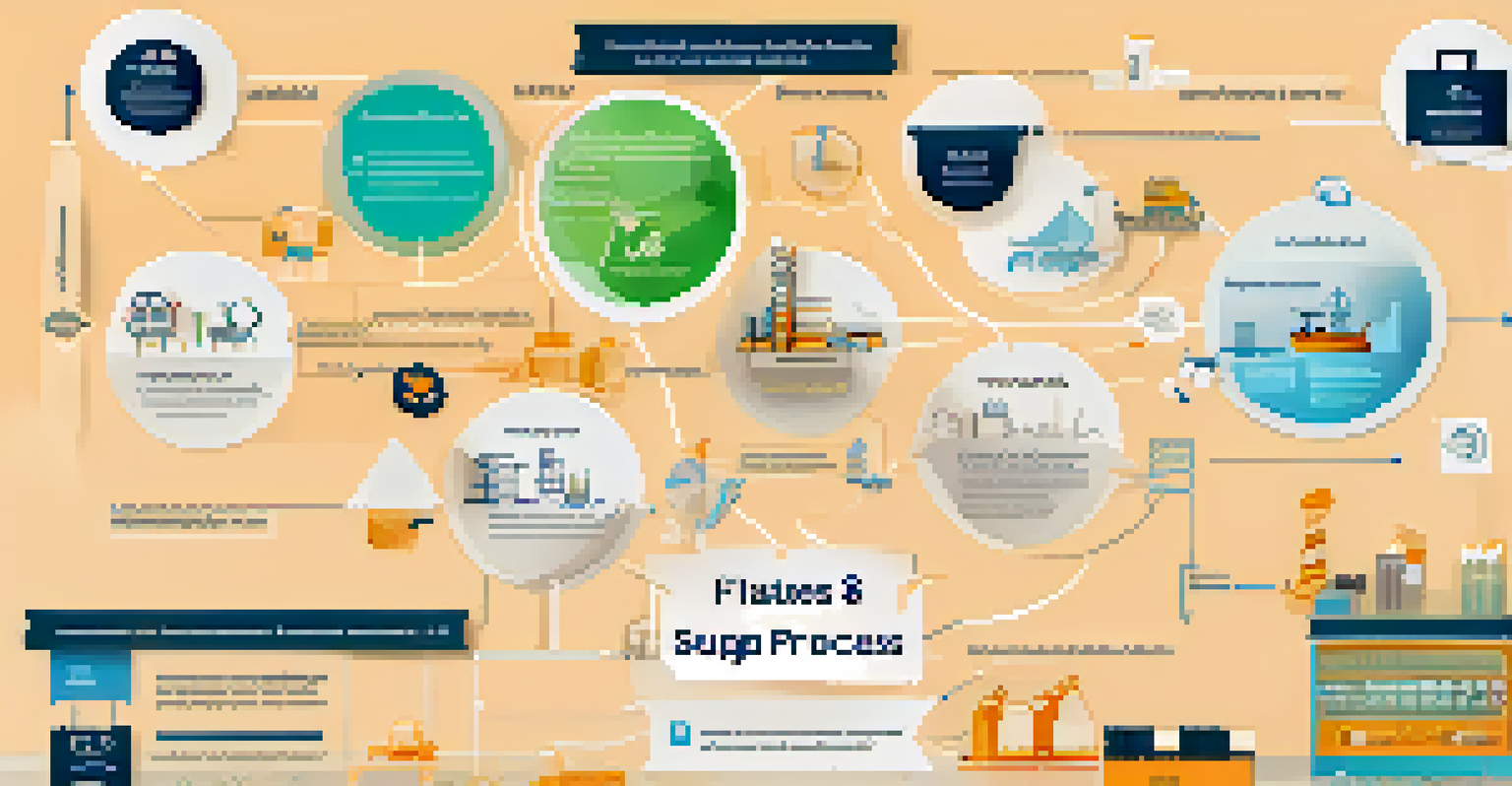Managing Supply Chain Risks in the Fashion Sector

Understanding Supply Chain Risks in the Fashion Industry
In the fashion industry, supply chain risks can emerge from various sources, such as supplier reliability, geopolitical issues, and environmental changes. These risks can disrupt production schedules, affect product quality, and ultimately impact consumer satisfaction. Understanding these risks is essential for brands to remain resilient and adaptable in an ever-evolving market. For instance, a sudden shortage of raw materials can delay a collection launch, affecting sales and brand reputation.
In the midst of chaos, there is opportunity.
Moreover, the fast-paced nature of fashion trends means that companies must be prepared for rapid changes in demand. This unpredictability can strain supply chains, making it crucial for businesses to not only identify potential risks but also to develop robust contingency plans. Fashion brands that proactively assess their supply chain vulnerabilities are better positioned to navigate challenges that could otherwise derail their operations.
By recognizing the spectrum of supply chain risks, companies can take informed steps toward risk mitigation. This involves not only monitoring external factors but also fostering strong relationships with their suppliers. A collaborative approach can enhance transparency and responsiveness, leading to a more resilient supply chain.
The Role of Technology in Risk Management
Technology plays a pivotal role in managing supply chain risks in the fashion sector. From inventory management systems to predictive analytics, digital tools can help brands anticipate disruptions and respond more effectively. For example, advanced analytics can forecast demand fluctuations, enabling companies to adjust their ordering strategies accordingly. This proactive approach can minimize excess inventory and reduce waste, aligning with sustainability goals.

Additionally, blockchain technology is gaining traction in supply chain management. It offers increased transparency by providing a secure and immutable record of transactions. This means that brands can trace the origin of materials, ensuring ethical sourcing and compliance with regulations. Such transparency not only builds consumer trust but also helps mitigate risks associated with supplier misconduct.
Navigating Supply Chain Risks
Fashion brands must understand and manage supply chain risks to maintain production schedules and consumer satisfaction.
Overall, leveraging technology allows fashion brands to gain deeper insights into their supply chains. By utilizing data-driven decision-making, they can identify potential risks faster and implement strategies to counteract them. This tech-forward mindset is essential for staying competitive in a landscape marked by volatility.
Building Strong Supplier Relationships
Establishing strong relationships with suppliers is crucial for mitigating supply chain risks. Trust and open communication can lead to better problem-solving and quicker responses to unforeseen issues. For instance, a brand that has a solid partnership with its fabric supplier may receive early alerts about potential shortages, allowing them to adjust their production plans accordingly. This collaborative spirit can significantly reduce the impact of disruptions.
Sustainability is no longer a nice-to-have; it’s a must-have.
Moreover, brands should consider diversifying their supplier base to minimize dependency on a single source. By having multiple suppliers for critical materials, companies can maintain flexibility and reduce the risk of production halts. This approach not only safeguards against supplier failures but also fosters healthy competition, which can drive improvements in quality and pricing.
Investing in supplier development programs can further strengthen these relationships. Providing training and resources can empower suppliers to meet quality standards and adopt sustainable practices. In this way, the entire supply chain benefits, leading to a more resilient and efficient system.
Implementing Risk Assessment Strategies
Regular risk assessments are essential for identifying vulnerabilities within the supply chain. Fashion brands should conduct these assessments periodically, focusing on both internal and external factors that could affect their operations. For example, assessing the geopolitical landscape can reveal potential risks related to trade tariffs or political instability in supplier countries. This insight allows brands to take preemptive measures, such as sourcing materials from alternative regions.
Furthermore, engaging cross-functional teams in the risk assessment process can provide diverse perspectives on potential challenges. Involving departments like production, logistics, and sales ensures that all aspects of the supply chain are considered. This holistic approach can help identify blind spots that may otherwise go unnoticed, leading to more comprehensive risk management strategies.
Leveraging Technology for Insight
Technology, including predictive analytics and blockchain, is vital for enhancing supply chain transparency and mitigating risks.
Ultimately, a proactive risk assessment framework enables fashion brands to stay ahead of potential disruptions. By continuously monitoring and evaluating their supply chains, they can adapt quickly and maintain operational continuity in the face of uncertainty.
Emphasizing Sustainability in Supply Chains
Sustainability is no longer just a trend; it’s a vital consideration in supply chain management for fashion brands. Companies that prioritize sustainable practices not only contribute to environmental conservation but also reduce risks associated with regulatory changes and consumer backlash. For example, brands that rely on eco-friendly materials may find themselves better equipped to navigate shifts in consumer preferences toward sustainable products.
Additionally, sustainable supply chains can enhance resilience. By focusing on local sourcing and minimizing transportation distances, companies can reduce their carbon footprint while also mitigating risks related to global supply chain disruptions. This localized approach can lead to quicker response times and a more agile business model, allowing brands to adapt to market changes effectively.
Incorporating sustainability into supply chain strategies also enhances brand reputation. Consumers today are increasingly conscious of the impact their purchases have on the planet. Fashion brands that commit to sustainability can differentiate themselves in a crowded marketplace, building loyalty and trust among environmentally-minded consumers.
Crisis Management and Contingency Planning
Crisis management is a critical component of supply chain risk management in the fashion sector. Companies must be prepared to respond swiftly to crises, whether they stem from natural disasters, pandemics, or supplier failures. Having a well-defined crisis management plan ensures that brands can maintain operational continuity and protect their reputation during challenging times. For instance, during the COVID-19 pandemic, many brands had to pivot quickly to address supply chain disruptions and changing consumer behaviors.
Contingency planning goes hand in hand with crisis management. Businesses should develop alternative strategies for sourcing materials, production processes, and distribution channels. By identifying potential backup suppliers or alternative logistics partners, brands can minimize downtime and ensure that they can continue to meet consumer demand even in the face of adversity.
Emphasizing Sustainability Matters
Prioritizing sustainable practices not only meets consumer demands but also strengthens resilience against market fluctuations.
Moreover, conducting regular crisis simulations can help teams practice their response strategies and identify areas for improvement. These drills create a culture of preparedness, enabling employees to respond confidently and effectively when real crises arise. This proactive approach to crisis management can significantly reduce the impact of unexpected disruptions on the supply chain.
Monitoring and Adapting to Market Changes
The fashion industry is characterized by its rapid changes in trends and consumer preferences. To effectively manage supply chain risks, brands must continuously monitor these shifts and adapt their strategies accordingly. This might involve utilizing social media analytics to gauge consumer sentiment or analyzing sales data to identify emerging trends. By staying attuned to market dynamics, brands can make informed decisions that align with consumer demands.
In addition to monitoring trends, brands should also keep an eye on economic indicators that could impact their supply chains. Factors such as inflation rates, currency fluctuations, and changes in trade policies can all affect sourcing and production costs. By being proactive in their analysis, companies can adjust their pricing strategies and sourcing choices to mitigate potential risks.

Ultimately, adaptability is key to thriving in the fashion sector. Brands that embrace change and remain agile in their supply chain management are more likely to succeed in navigating the complexities of the market. This forward-thinking mindset not only enhances resilience but also positions brands for long-term success.